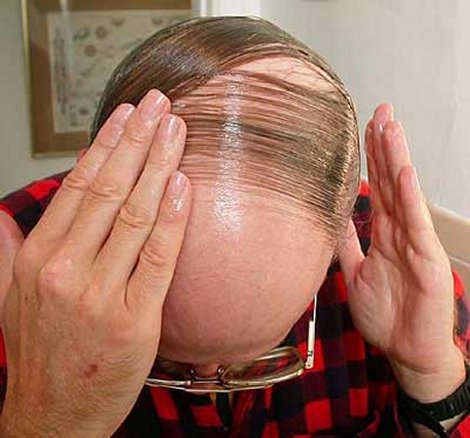Male Pattern Baldness and Norwood Scale

Male pattern baldness is the most common hair loss diagnosis in men. It is a permanent type of alopecia (hair loss) which is caused by hormones and genetic predisposition. Millions of men on the planet go bald and if one pays attention, the patterns of their hair loss are typical.
As a rule, pattern baldness starts at the temples and/or crown of the head. One does not just wake up without hair, the process starts slowly and progresses until after several years it ends up in total baldness or hairless patterns on top of one’s head which is more common.
Why does it happen that men experience pattern baldness?
Almost every millimeter of our skin has hair follicles which provide hair growth. A new hair strand starts its life in a follicle, develops for a couple of years growing by one or two inches a month and goes to resting phase. Three-four months later it falls out being replaced by the new hair strand.
After puberty the level of male hormone, testosterone, increases. One of its derivatives, dihydrotestosterone (DHT) is aimed to stop hair growth. Under the influence of the hormone, hair follicles shrink producing small weak hair. After several years the follicles get so little that they become unable to grow any hair. However, the follicles are not dead and even though they are very small, there is a possibility that one day they will still be able to grow hair.
It is usually easy to notice the beginning of pattern alopecia. At hair line the strands become thinner, shorter and weaker. With the time they lose color and fall out making and “M” shape. Simultaneously with this, crown hair starts getting finer as well.
The type of patter baldness is usually diagnosed by appearance. A dermatologist also would ask some questions about genetic background, medical history, etc. After this the specialist should examine the scalp with magnification to figure out the degree of the follicle miniaturization.
As a rule, hair densitometer can be used to determine hair density. This devise contains magnifying lens and an opening of predetermined size. Before the exam a small part of the scalp has to be shaved (to approximately 1 mm) and then the densitometer can be placed on this spot. Sometimes measurements have to be taken from several parts of scalp for the best result.
Sometimes expensive hair loss analysis might be offered, but it is not useful in usual pattern baldness, however, it shows the possibility of poison-induced hair loss (for example, if there is a high concentration of lead). For typical pattern alopecia this exam is not required and will only be a waste of money.
The following scale is a standard to classify male pattern baldness. It was developed by Dr. James Hamilton in 1950’s and modified 20 years later by Dr. O’Tar Norwood.

Type I. Minimal hair loss.
Type II. Insignificant hair loss at the temples.
Type III. The first stage of pattern baldness that requires treatment. The shown areas either have no hair at all or barely covered with any.
Type III vertex. Hairline patters are not as big as in the previous type, but there is a small pattern on the back of the head.
Type IV. Bigger patter on the vertex. However, hairline and vertex are divided by a thick line of hair.
Type V. The division line is thinner, but it is still present although the patterns at the hairline and vertex are bigger.
Type VI. The bridge is gone although it might be presented by several strands of short fine hair.
Type VII. The most severe form of hair loss. There might be little hair on the front or top of the head.
The treatment of male pattern baldness is not necessary if one feels comfortable with it. However if it brings stress and anxiety, there are specialists who can help with the problem right after they identify the kind and pattern of hair loss.
Jessica Bloom
Posted on April 8, 2009
Filed Under Hair Loss, Hair Loss Conditions, Hair Loss Diagnosis, Hair Loss News and Statistics, Hair Loss Reasons
Comments
Leave a Reply
